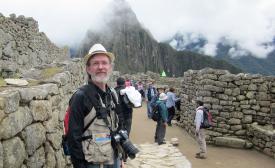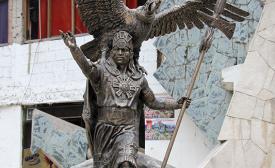A word from the MC Sask moderator
As the new moderator of Mennonite Church Saskatchewan, I am dealing with feelings of anticipation, apprehension, excitement and a little fear.
As the new moderator of Mennonite Church Saskatchewan, I am dealing with feelings of anticipation, apprehension, excitement and a little fear.
In the last couple decades, most churches caught the mission statement bug. To revisit, renew, or finally wrestle with a reason for being is crucial for any organism. As human beings we all eventually ask the big “why” of existence, so why should it be any different for groups of human beings?
I’m not exactly a new Canadian as I arrived in Vancouver back in 1989, leaving behind my hometown of Dadwan, Punjab, India.
My grandparents were traditional Hindu and Sikh, but my father joined the British army and so converted to Christianity, though he was a very nominal Christian. My mother had been born into a Sikh family, but she attended a Catholic Church.
Mennonite World Conference held its first assembly in 1925, which was the 400th anniversary of the beginning of the Anabaptist movement. With the 500th anniversary now only 10 years away, many people are wondering how MWC plans to commemorate it.
Thanks to those who attended TRC report in Ottawa
“All through the long winter I dream of my garden. On the first warm day of Spring I dig my fingers deep into the soft earth. I can feel its energy and my spirits soar.”
~Helen Hays, quoted in Like a Garden: A Biblical Spirituality of Growth by Sara Coven Juengst (Westminster John Knox Press, 1996)
So Jesus was striding down the street one day when a kid in front of him turned around and asked for a bus ticket. Jesus had noticed the boy—a skinny teenager wearing a too-big T-shirt—aimlessly tapping a stick on a nearby fence. Jesus had wondered why the boy wasn’t in school, and if he was waiting for an adult doing business at the auto shop or picking up a coffee at the Tim’s.
“Another of his disciples, Andrew, Simon Peter’s brother, spoke up, ‘Here is a boy with five small barley loaves and two small fish, but how far will they go among so many?’” (John 6: 8-9)
The fragrance of old books mingled with stale pipe tobacco washed over me like finely aged wisdom, fermented from years of deep contemplation. Every wall of the late history professor’s study was concealed behind rows of shelves fully stocked with hardcover and paperback treasure. My sense of gratitude for the invitation to come “pillage” Robert’s library morphed into unbridled excitement.
In the year 2000, world leaders set themselves a deadline for dramatically decreasing global poverty. That deadline was 2015.
I have had a recurring dream that began after a trip to Italy. During my time there I visited at least 50 churches and was struck with the fact that many claimed to be the home of sacred relics—especially bits of the cross of Christ.
If Christ is not the head, the church suffers dementia
On our deck there sits a small pot. It has been sitting in much the same spot for over a year. My youngest son is a budding gardener, and in the pot that sits on that spot, he dropped an apple seed. Yes, one of his middle names is John.
In a couple weeks, my family and I will move to my hometown, Regina, where I’ll start school next fall. Maybe it’s because I’m in a time of transition in my personal life—books packed up, clothes and toys in boxes, cleaning buckets everywhere—but I’m sensitive to winds of change around me.
It’s been 25 years since the military faced off against Mohawk Warriors in the pine forest between the village of Oka and the community of Kanehsatake, 53 kilometres west of Montreal. The 78-day armed siege was the most violent and consequential clash between indigenous people and the Canadian state in modern times.
What has changed since then?
In the summer of 1990 the Canadian military faced off against Mohawk Warriors between the village of Oka and the community of Kanehsatake, 53 kilometres west of Montreal, Que. This led to a 78-day armed siege, the most violent and consequential clash between indigenous people and the Canadian state in modern times.
What do Martha Stewart and Yvonne Johnson have in common? They both spent time in prison. Stewart, wealthy and famous, served five months for manipulating stocks, while Johnson was charged with first degree murder and sentenced to life imprisonment. This is where the similarities end.
Integrity doesn’t hinge on the name ‘Mennonite’
Re: “ ‘Mennonite’ name should stay” letter, March 30, page 10.
’Tis the season of graduations. Society recognizes graduation as an important transition in the lives of young people and so we ritualize the event with special ceremonies. At a typical ceremony young people hear various words of encouragement: A whole world of opportunity lies before you. Pursue your passions and dreams. Become whatever you want to be.
Looking out the café window on a warm spring day, I watched as a short, rotund man pulled off his shirt and bared his quite large tummy to the friendly rays of the sun. “There’s a man sitting at the bus stop who’s just taken off his shirt—” I started to tell my companion, a pastor colleague thirty years my junior.
“What?” he teased. “Is that driving you to lust?”
A will is your last communication with your family. Many of us are uncomfortable planning for our death, but the chaos, confusion and potential for conflict in families where there is no will should offset your discomfort. A properly written will explains how you want your assets distributed.
The brilliant Jesuit priest Pierre Teilhard de Chardin said, “The world is in truth a holy place.” He was echoing the words of the prophet Isaiah who wrote, “the whole earth is filled with God’s glory.” God’s presence and glory can be perceived anywhere if we have “eyes to see and ears to hear.” Yet it is clear certain places, people and things help us tune into the reality of God’s presence mo

Dave Rogalsky explores the ruins of Machu Picchu, the mountaintop retreat and administrative centre of the ancient Incan empire. (Photo by Annemarie Rogalsky)

The ruins of Machu Picchu, the mountaintop retreat and administrative centre of the Incan Empire. (Photo by Dave Rogalsky)

Atahualpa Inca with the condor, puma, and snake—the guardians of the sky, earth and underworld in the cosmology and religion of the Incas. By the time the European explorers reached Latin America, the Incan civilization had assembled a significant empire from southern Panama deep into Chile. (Photo by Dave Rogalsky)
It was a huge painting. At least 3 x 3 metres. It was part of a show in the Dominican church of San Domingo, built over and incorporating Qurikancha, a central Inca complex in Cuzco, Peru. My congregation, Wilmot Mennonite Church near Baden Ont., had given me the privilege of travelling to Peru for two weeks in early May this year.
‘What a blessing’ the Bible is
Re: “Bible reading meant less Canadian Mennonite reading” letter, March 30, page 13.
How to plant a church is not a big mystery. Any good Mennonite gardener knew how to take a clump of bulbs from her front garden, split them up and transplant them into the bed at the side of the house. In the spring, the new garden proudly displayed the same brilliantly coloured daffodils and tulips for all to enjoy.